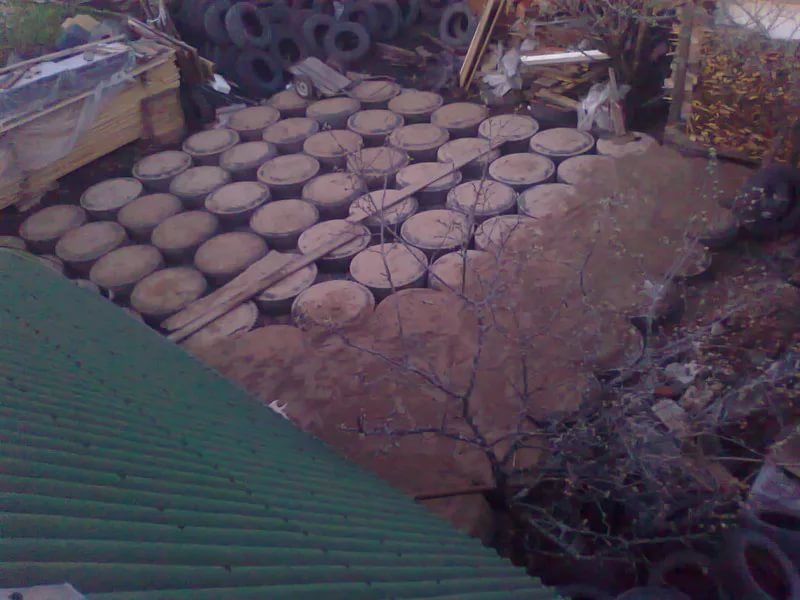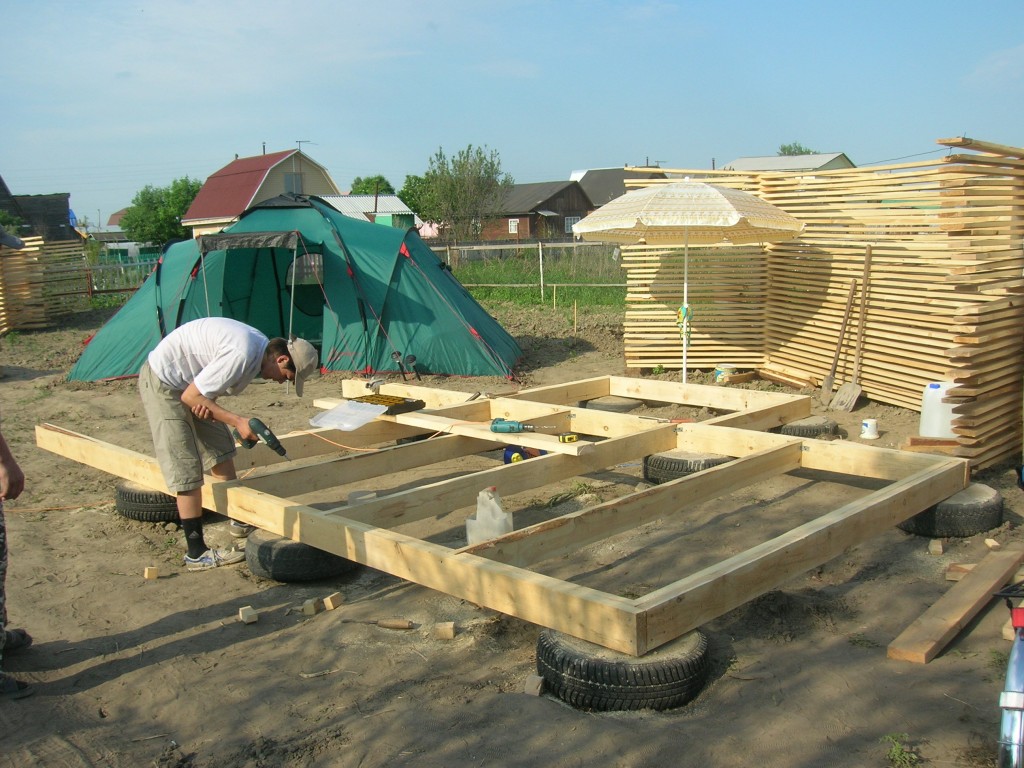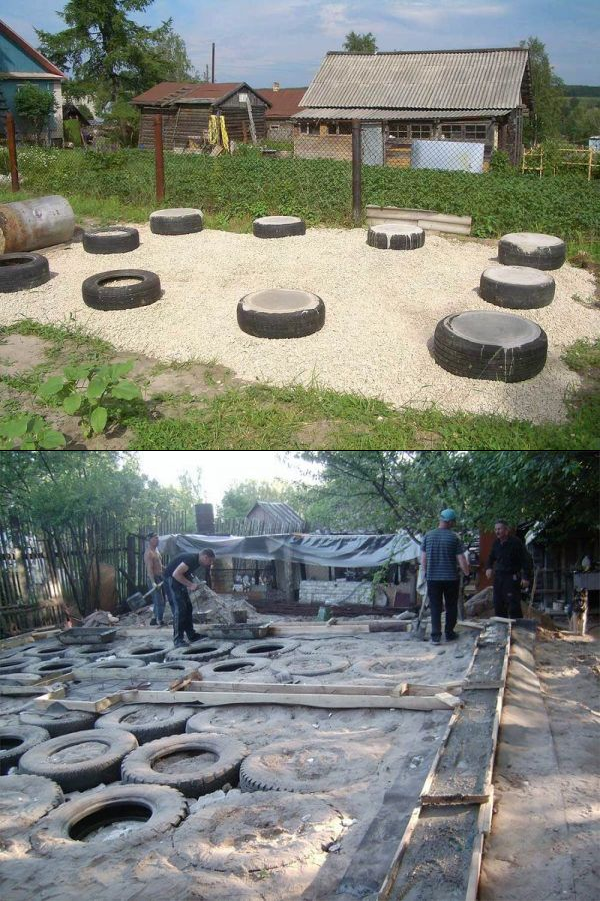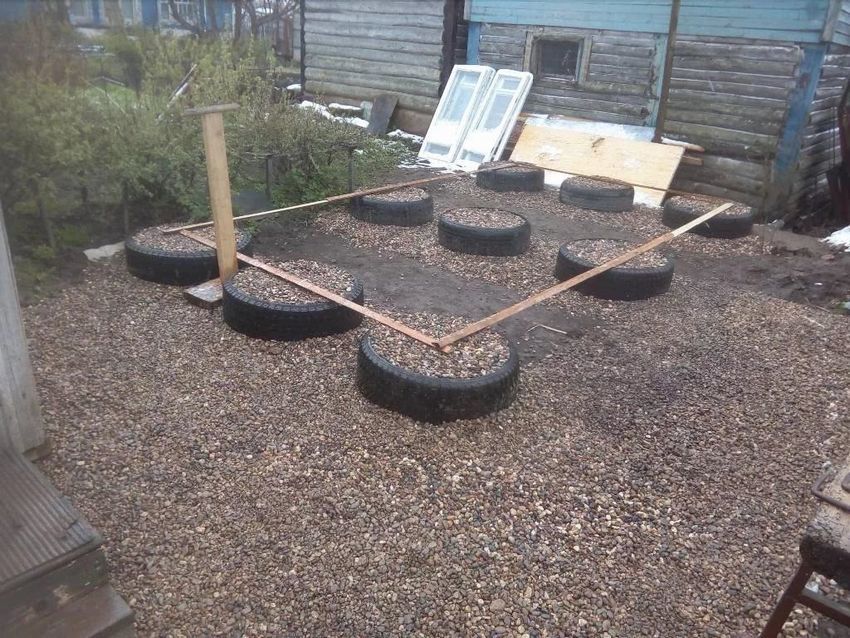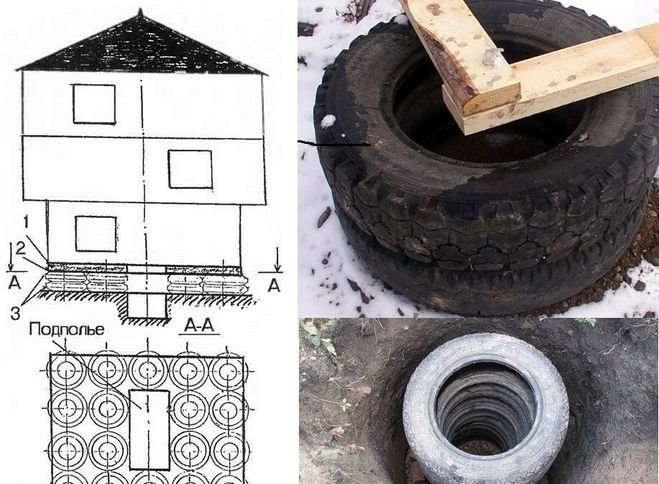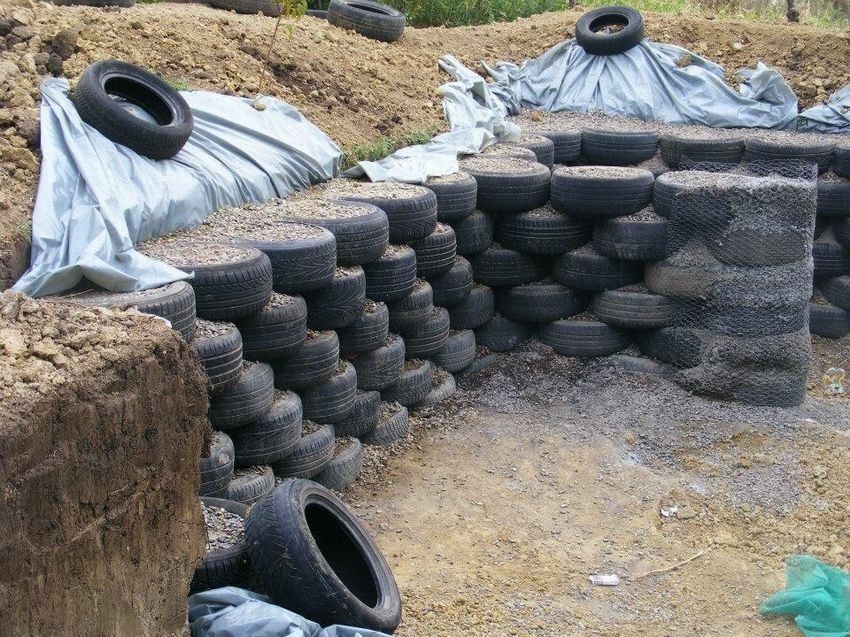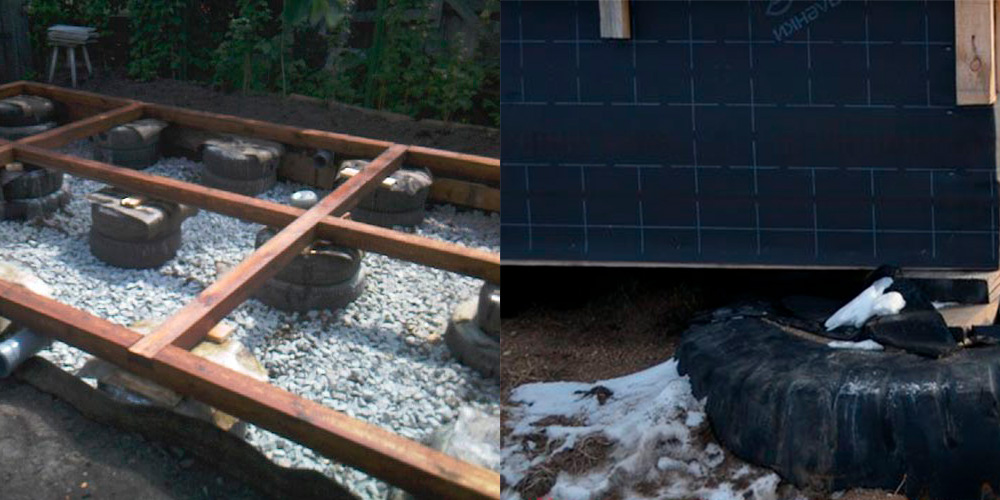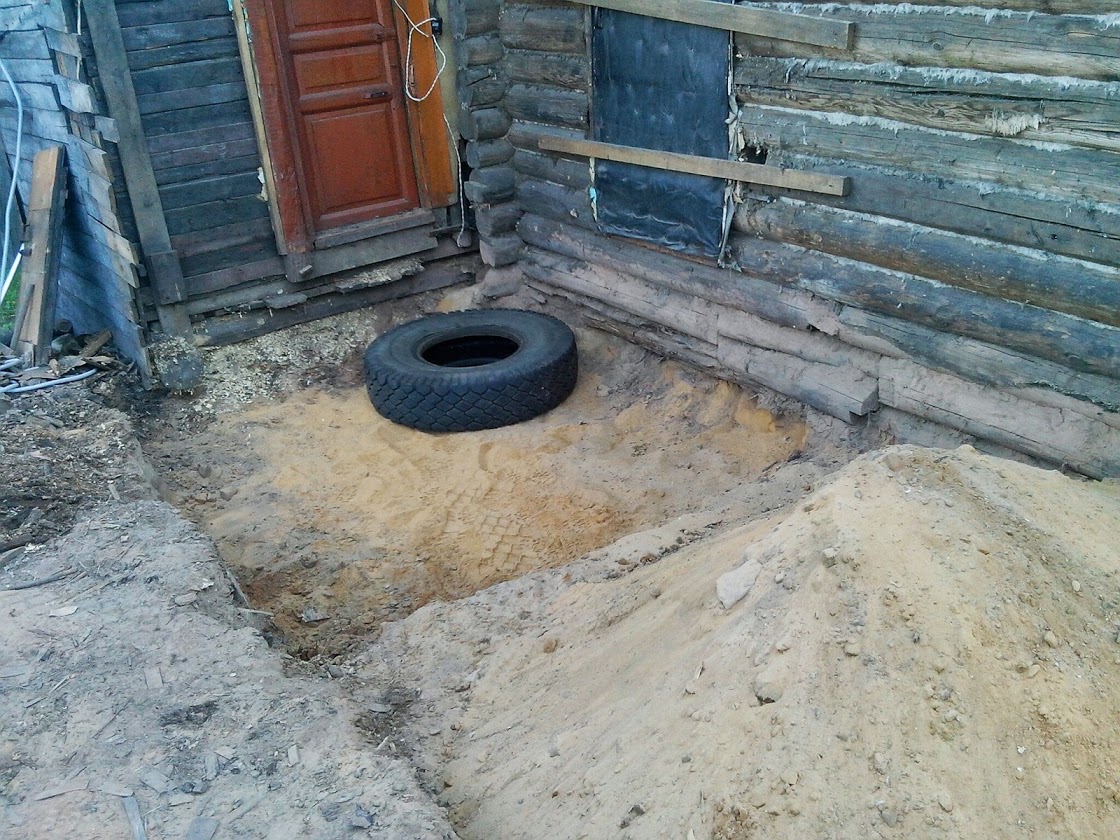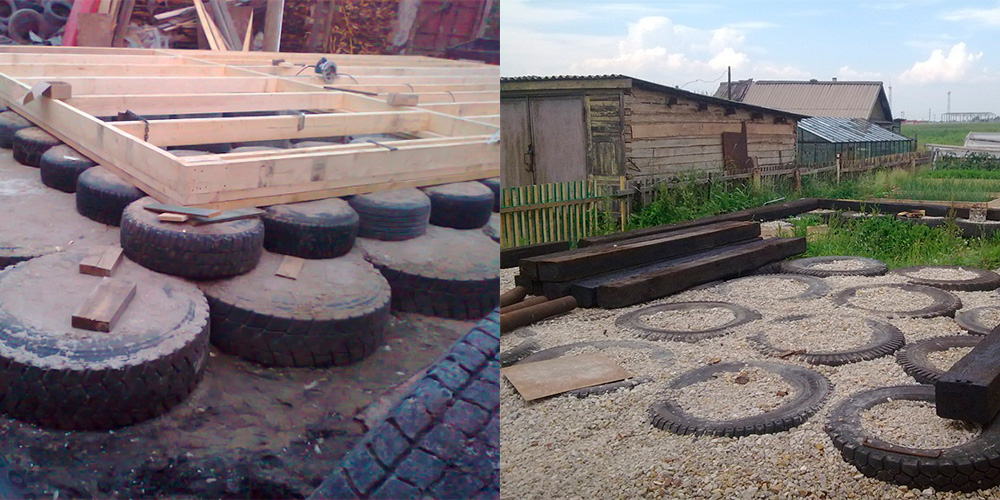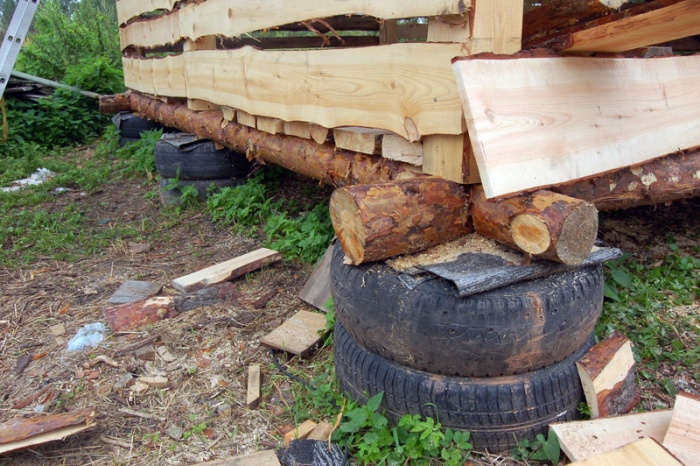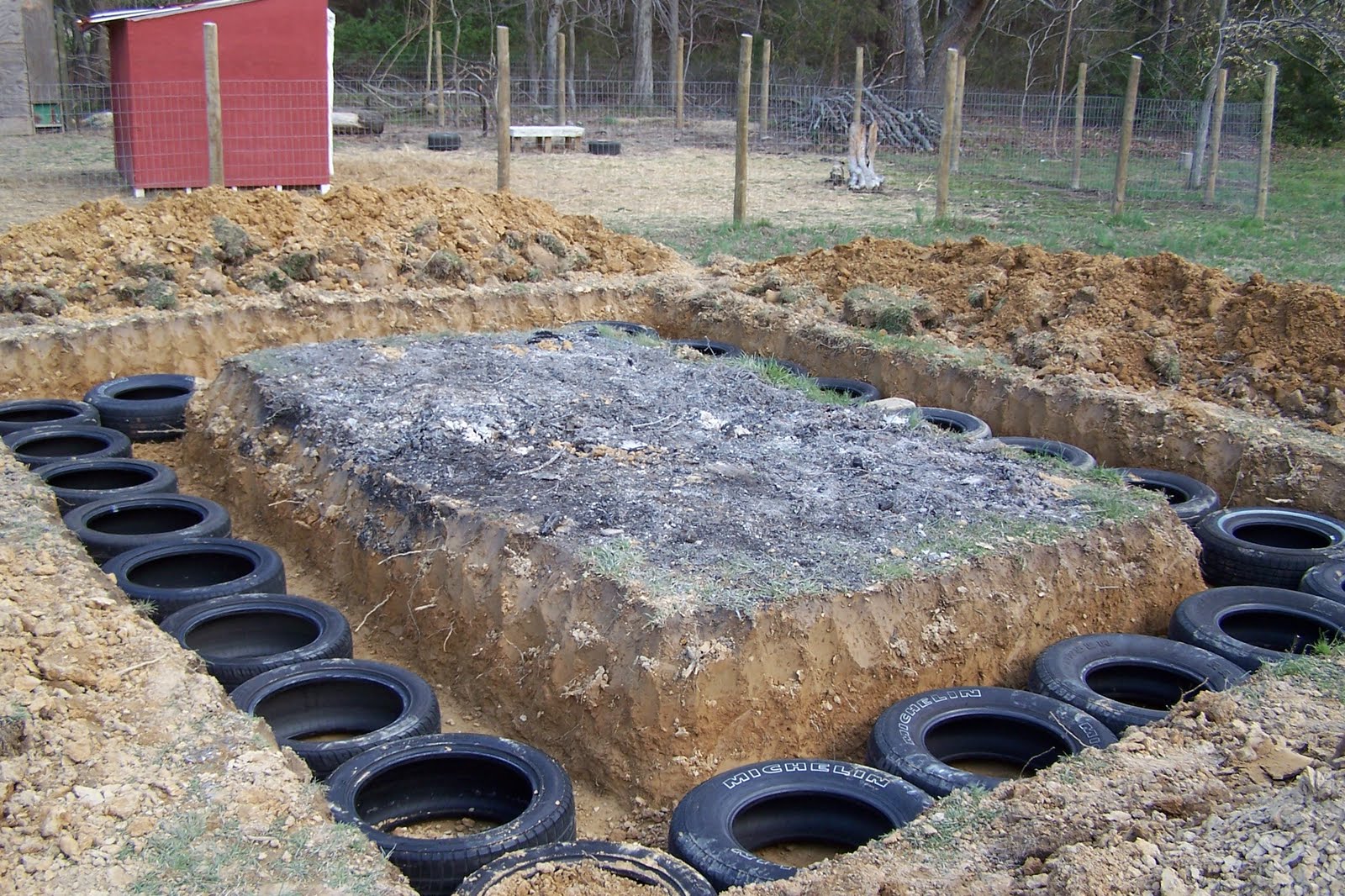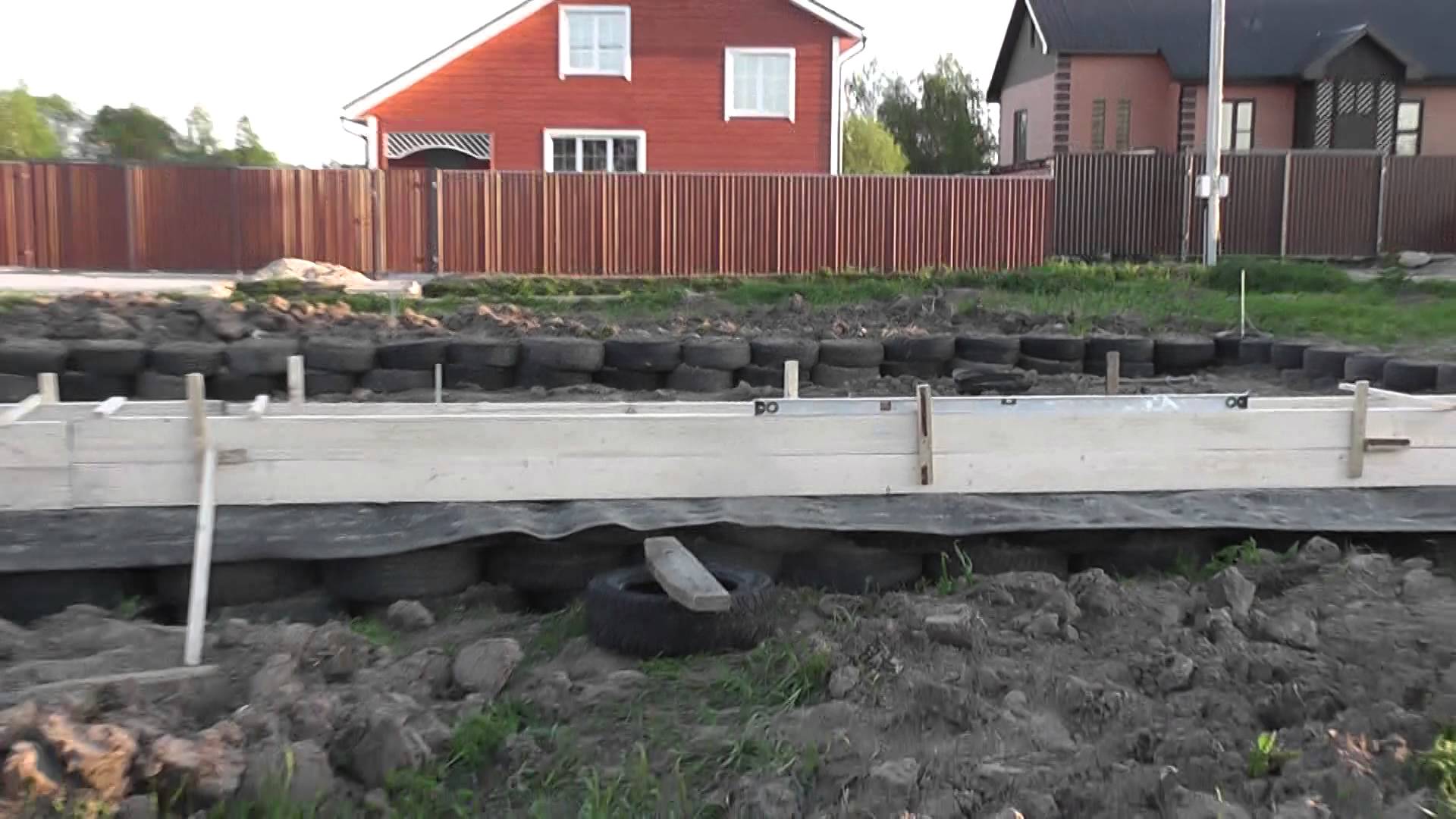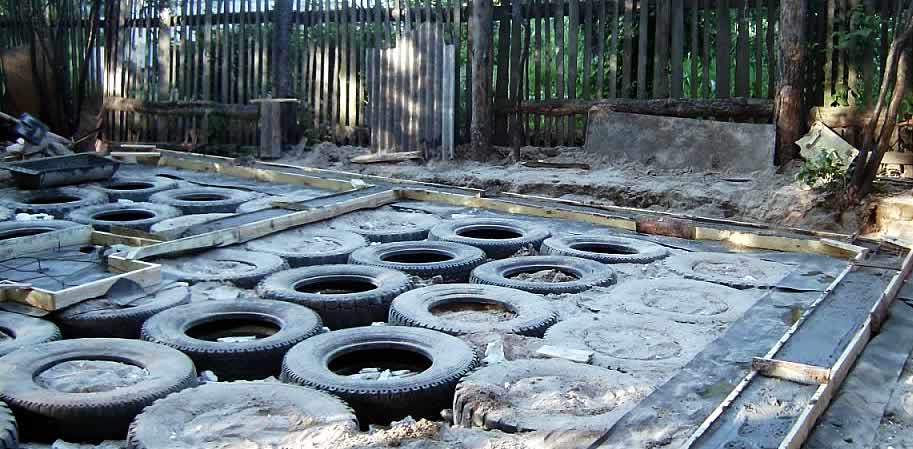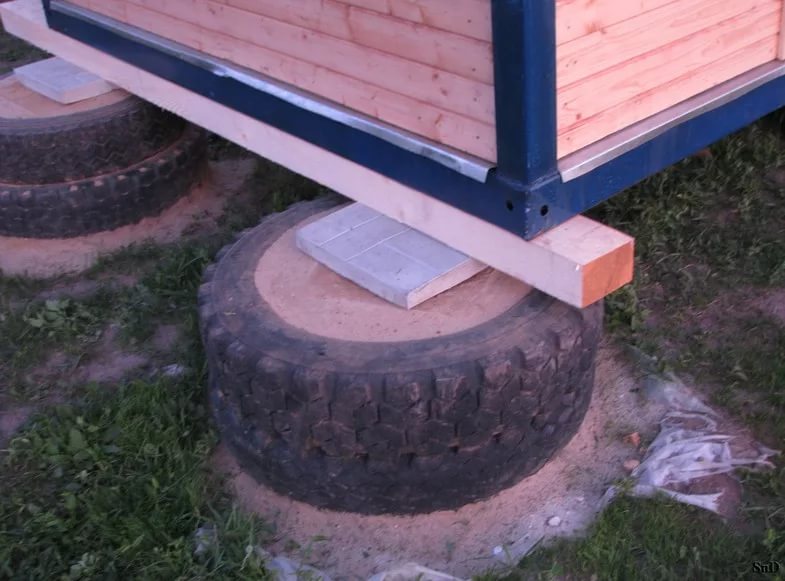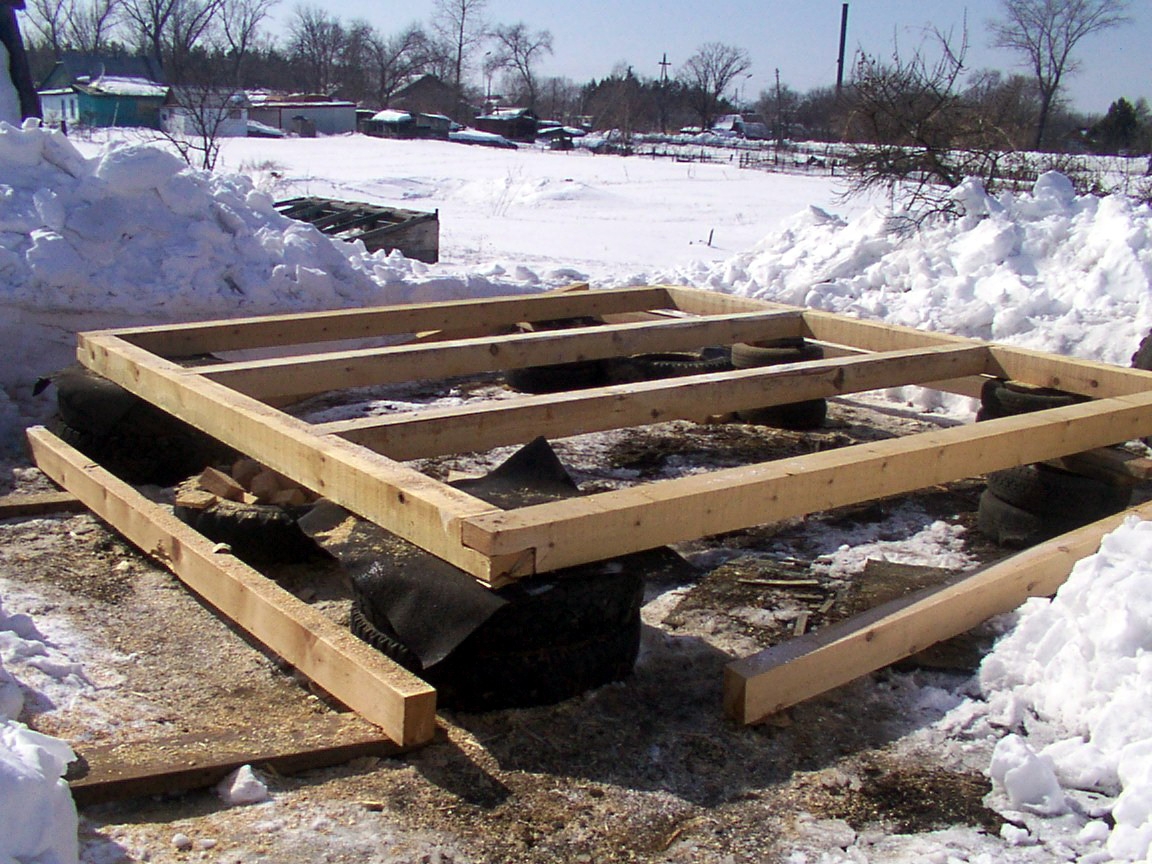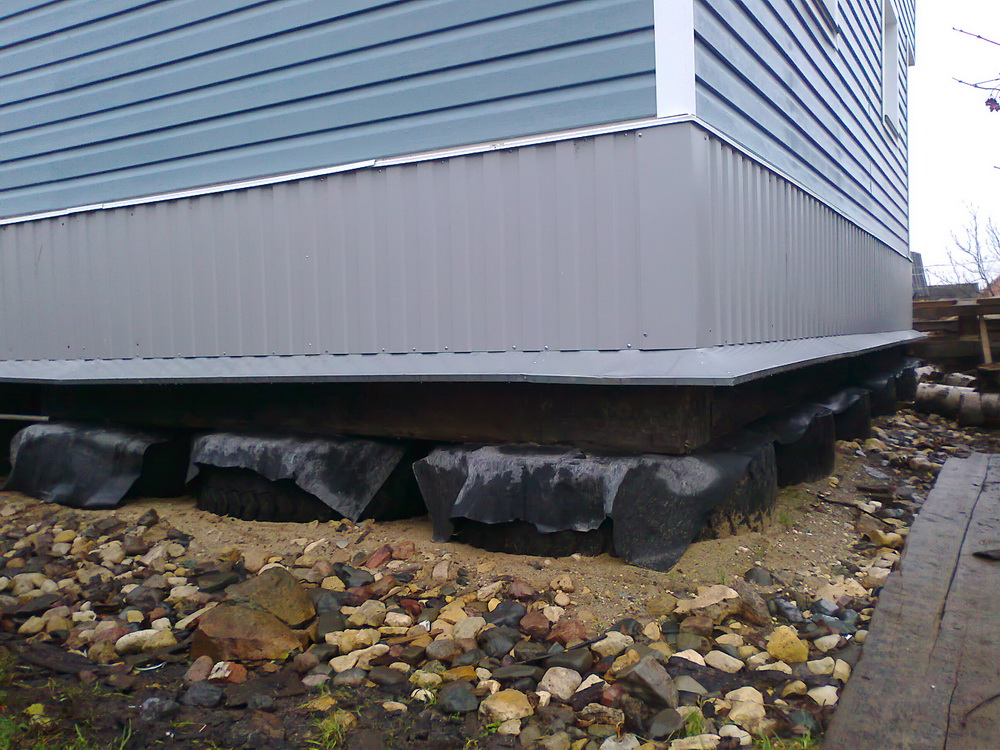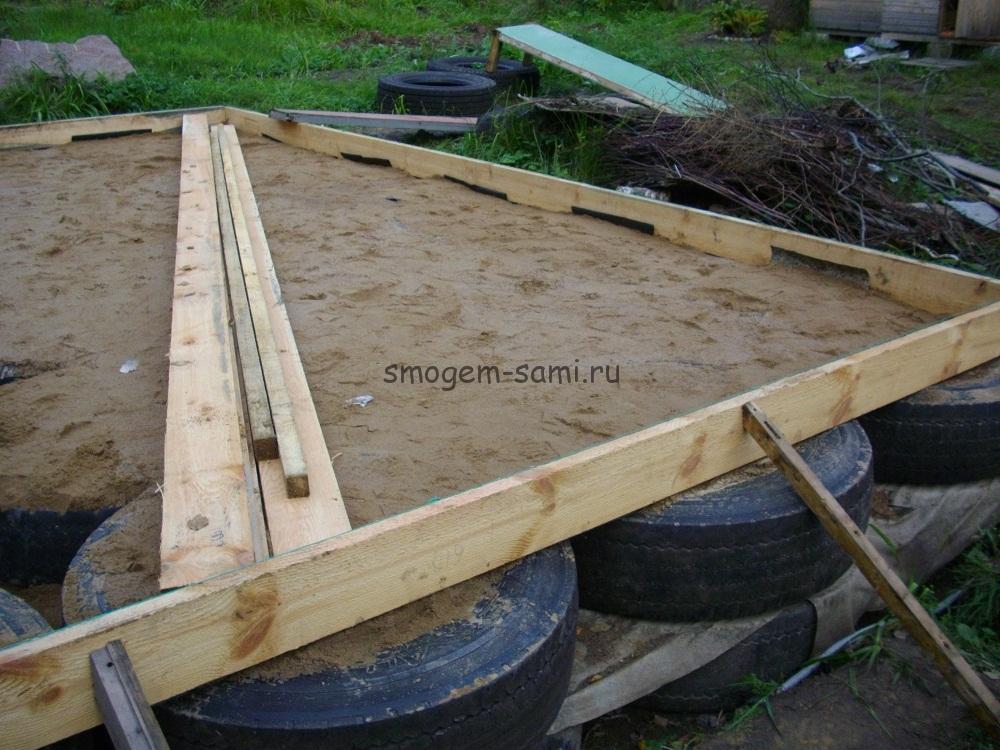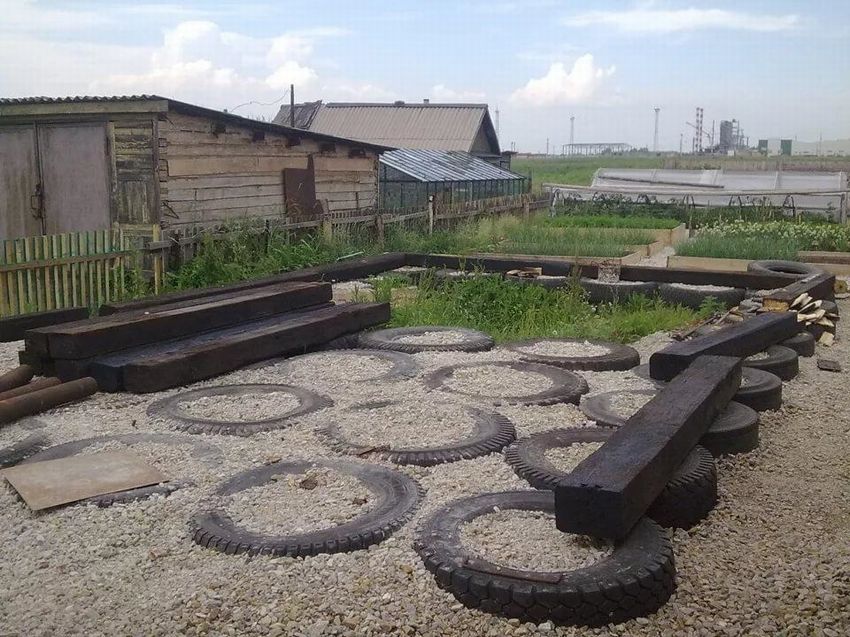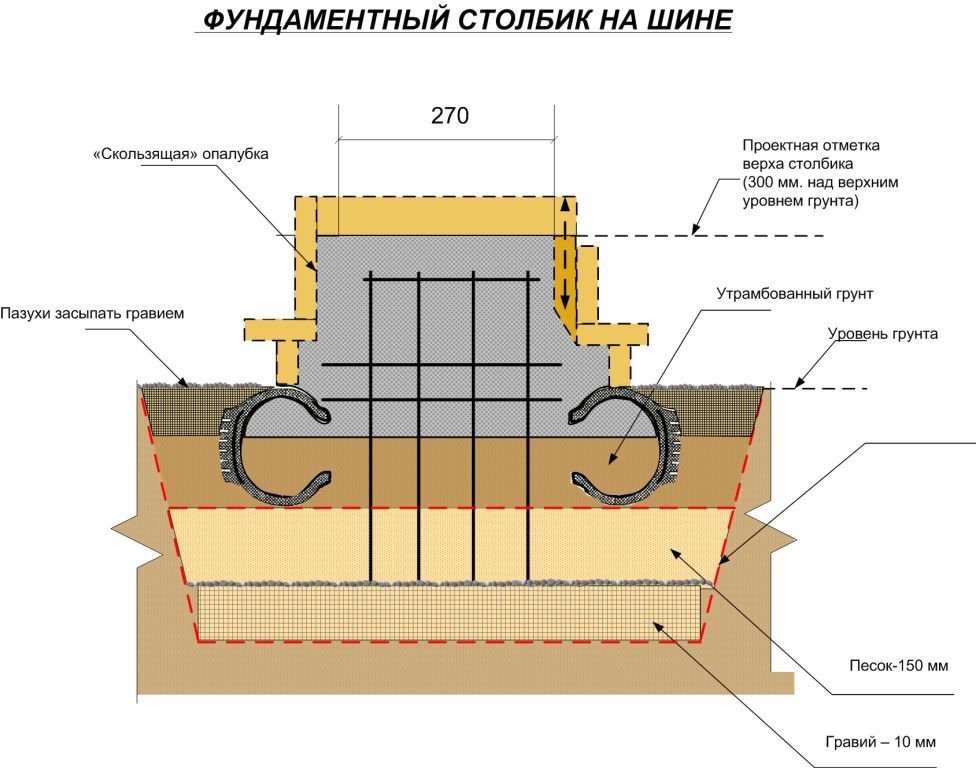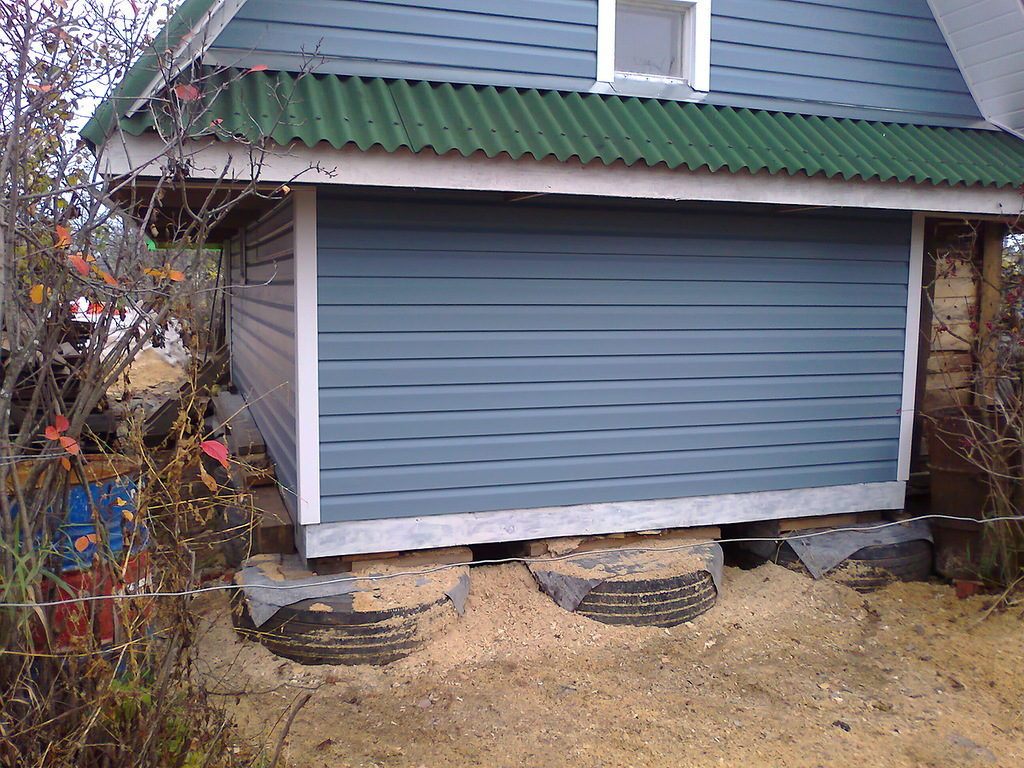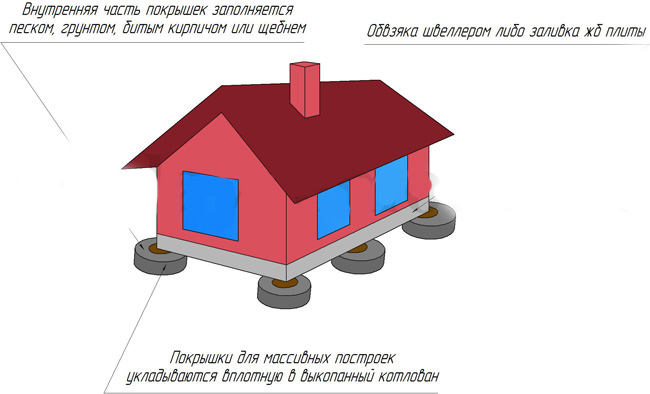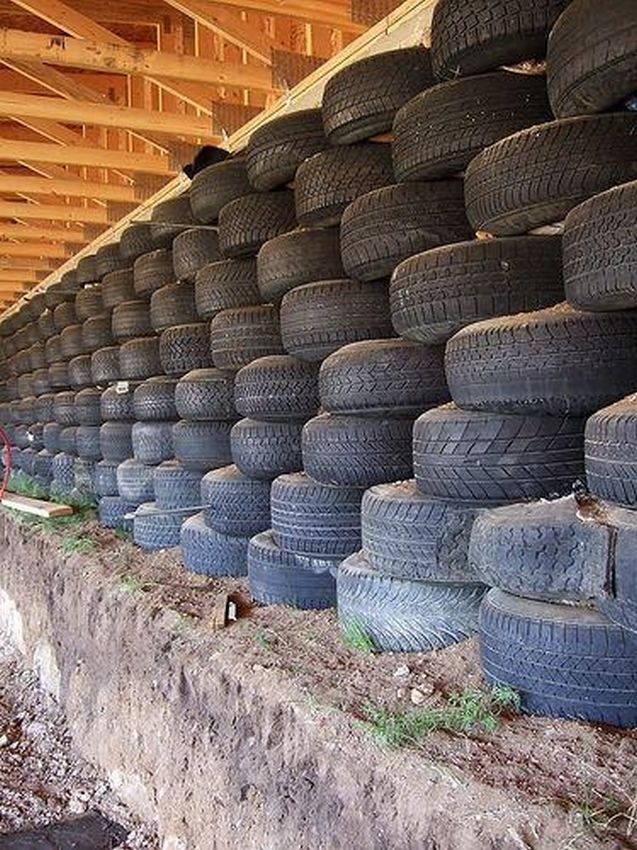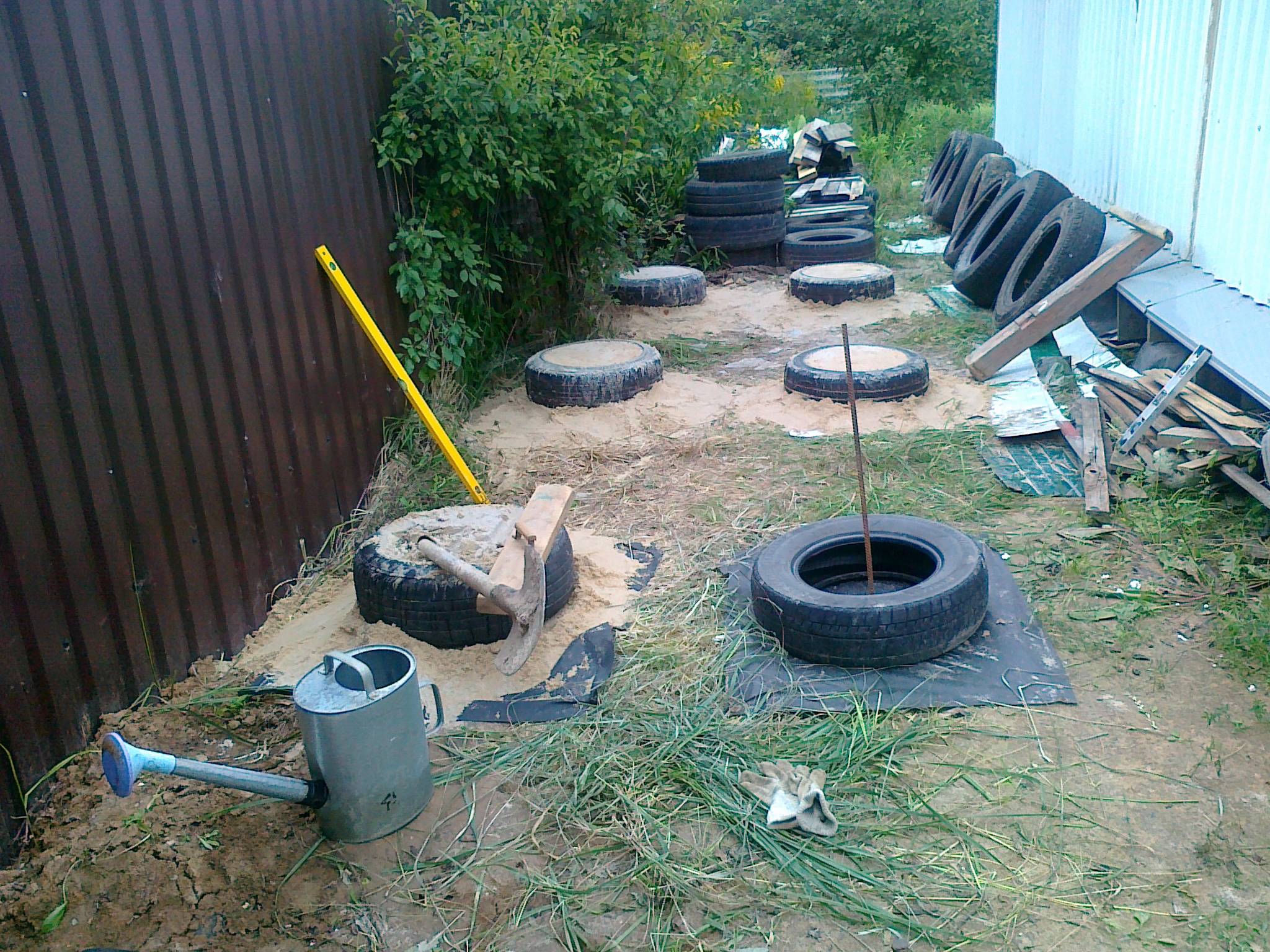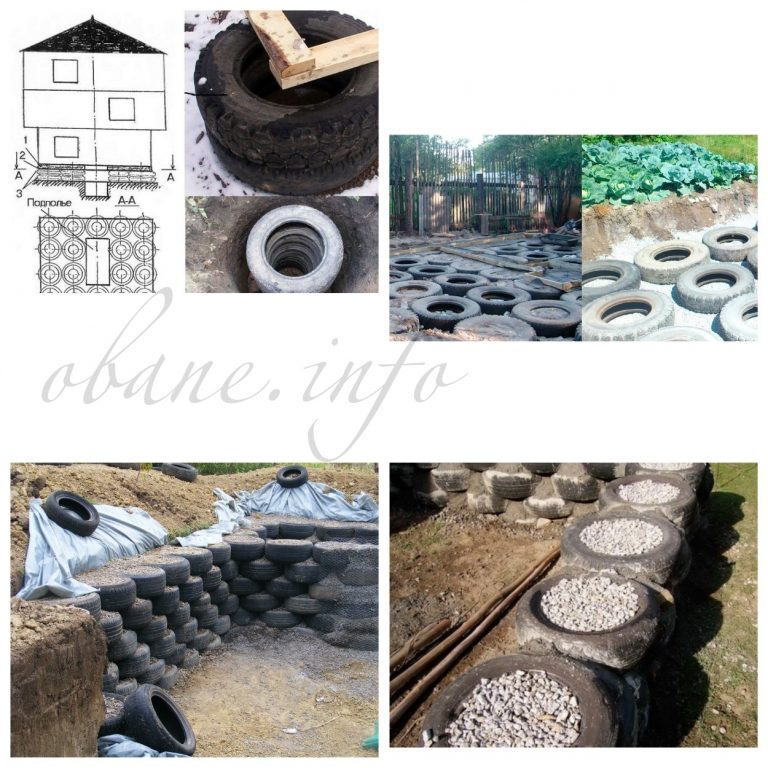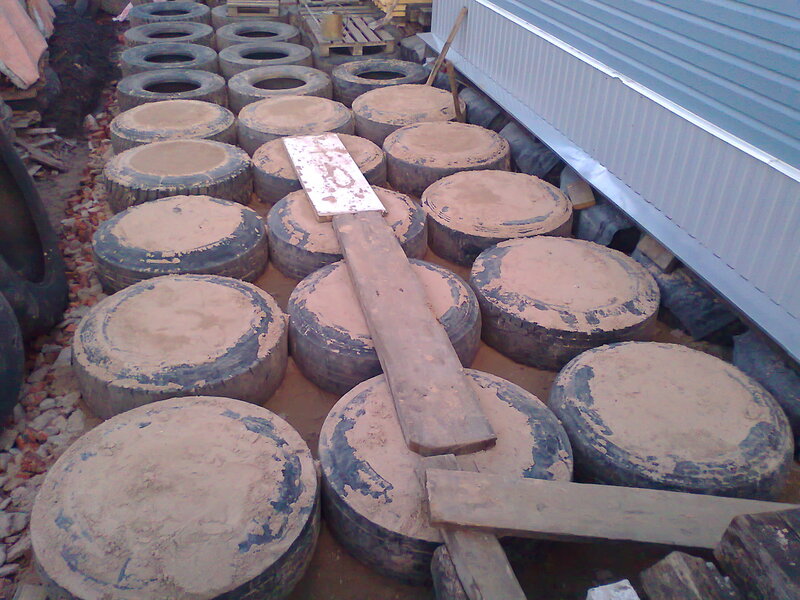How to do it?
First of all, it is necessary to prepare a project and an approximate estimate. But you also need to calculate the load, and decide on the type of soil. The drawing should initially be made on paper, and during the execution of work, strictly follow it.
To lay the foundation from old car tires, in addition to the wheel products themselves, other tools and materials will be required:
- a shovel to dig a pit;
- rake for leveling the surface;
- crushed stone and gravel to fill the voids between the tires;
- cement mortar and sand for it;
- fittings;
- building level;
- broken brick to fill the tires from the inside;
- roofing material from which the leveling layer and waterproofing will be made.

The technology for installing different types of foundation has its own differences.
Platen
Before erecting any of the foundations, you must first clear the area and remove the debris. Removal of the vegetation layer should be carried out about half a meter deep, after which the site needs to be leveled. Next, fragments of brick or crushed stone are poured, again leveling and compaction.
It is better to use tires from wheels of heavy trucks or other large vehicles. Large tires must be laid in rows and very tightly, and then filled with roofing material, which has the function of a waterproofing agent and holds the padding. Further, fragments of brick, earth and sand are poured inside. The packing should be laid as tightly as possible, the shock-absorbing properties of the tires and the level of load on the structure depend on it. In cases where the base needs to be made as rigid as possible, it must be poured with concrete.

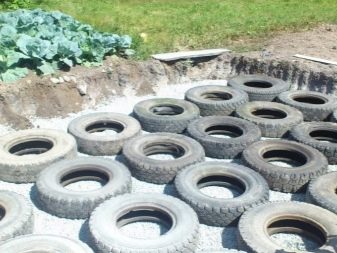
Next, you should fill the voids between the tires with prepared materials, with the exception of sand, which can settle. After that, the formwork is mounted, which should be wide enough to overlap the outer edges and protect them from the negative effects of sunlight. When these works are completed, the base is covered with roofing felt to improve the waterproofing properties.


When concreting, first of all, you need to clean the formwork and the place of work itself, remove debris and oil stains. After that, beacons are installed, by which the level of the concrete surface will be determined. The concrete mixture itself must be plastic in order to fill all the voids without problems without the use of additional tools. Concrete can be compacted using special mechanisms or manually, the main thing is that the process is carried out efficiently.
The base itself should be as flat as possible, this is checked using a building level. The maximum deviation in this case is 10 millimeters per meter. After that, the structure is left for a period of about a week for the concrete to gain strength. The formwork is removed one day after the mixture has been laid. The finished foundation looks like a monolithic slab; the structures of the structure are installed on it. The lower parts of the structures must be fixed to the anchors.
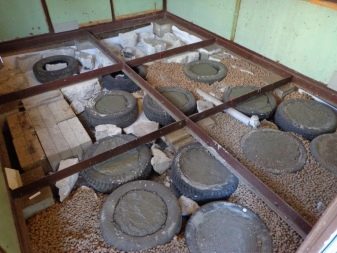

Tape
The technology for installing the strip foundation, despite the similarity to the slab, has its own characteristics. First of all, you need to determine where the axes of the bearing walls and partitions will be located. Pegs are installed at a distance of at least one meter from the axles. This is important as it helps to distribute the load correctly.
Next, you should dig a trench in accordance with the location of the axes. Its width should exceed the width of the tires, and the depth should be less than the soil is able to freeze through. Tires are laid in at least two rows and filled with prepared materials /
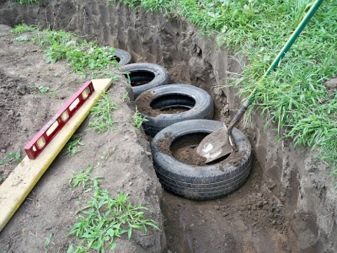

Columnar
When installing a columnar foundation, a thick layer of soil is removed before starting work. After that, you need to dig a pit of the required size. It is filled with gravel, which is carefully compacted.
Criteria for choosing a foundation for a gazebo
The foundation is the fundamental part of any, even the smallest, structure. Any foundation is bad and does not fulfill its functions if it is built incorrectly.
Basically, there are very few types of foundations. They all have a certain depth; lie on a cushion of draining rubble, pebbles, sand. There is always waterproofing between the foundation itself and the structure erected on it. As exceptions, pile foundations can be noted, which do without a pillow (although sometimes there is a buried pile foundation grillage), and not buried, simply lying on a pillow, foundations used for the lightest buildings.
Types of foundations
By the depth of location, all foundation foundations are subdivided into buried, shallow and not buried.
By engineering design, they are divided into four main types: slab, tape, pile and columnar.
Platen
It is used in cases of quicksand, close occurrence of waters, subsiding soil. Advantages: solidity, reliability; in our case, a thin monolithic foundation can be much more convenient than a strip foundation, since a platform is immediately created - the floor of the gazebo. Disadvantages: requires more labor and more materials than other types, respectively, it is more expensive.
The heavy slab foundation shown in the diagram is, of course, redundant for the gazebo
Tape
Usually, strip foundations are the most popular option, but not for gazebos. Advantages: solidity, reliability. Disadvantages: completely redundant for a gazebo. Although if it is very heavy, then a strip foundation is preferable to a monolithic one - it is cheaper and better copes with soil deformations.
A strip monolithic foundation is not the best solution for a gazebo
Pile
These are supports of a small cross-section, deeply embedded in the soil and well-fixed in it - asbestos-cement or metal pipes. Rarely, but still sometimes such a foundation is made of a wooden beam, but its special preparation is necessary. In some cases, factory-made metal screw piles are used, which increases the reliability of the structure and adhesion to the soil. Advantages: ideal for unstable soil, when building on a slope; pile asbestos-cement pipe foundation does not require large financial investments. Disadvantages: requires labor and great care when strengthening the piles and is often unnecessary in the case of building a gazebo.
Pile foundation with screw piles and concrete grillage used on slopes
Columnar
The lightest in execution and most often used for gazebos is the foundation. Sometimes it is buried, shallow and not buried. For gazebos, the last two types are used. The blocks are placed on a crushed stone or gravel bed either directly on the cleared area or in the pits. Advantages: extreme ease of execution, very cheap, suitable for any soil. There are no downsides.
Column foundation made of blocks with a wooden grillage - the best solution for a gazebo
Video: construction of a slab foundation for a gazebo
Since your main house has already been built, you already have on hand the expert opinion on your grounds, made before designing it. Moreover, you already know how your buildings behave: what are subsidence, soil shifts, flooding. The choice of a type of foundation for a gazebo or veranda will be based on the opinion of professionals and your own personal experience. Of course, you have to consider the indicators of the site survey.But in the case of a gazebo, everything is much simpler: the requirements are not so stringent; deepening is either insignificant or absent; the grillage is the simplest.
Construction of a rubber foundation from tires
In order for the base of tires to serve for a long time and at the same time to reliably hold the bath, it is necessary to correctly perform all the work on its installation, as well as to provide reliable protection from exposure to sunlight. The main criterion when creating a foundation from car tires is to control their positions in the same plane and at the same level. Errors here can lead to a distortion of the entire foundation.

The construction of a slab foundation consists of several stages.
They dig a pit 20 cm deep according to the dimensions of the future bath, retreating along the perimeter by 20 cm. Such a measure is needed so that the outer edges of the tires are also closed during concreting. This will not only strengthen the base, but also prevent the release of harmful substances under the influence of sunlight. The depth of the pit does not depend on the thickness of the tires.
Checking with a water level, they level the bottom of the pit, constantly tamping it.
On a flat surface, the tires are laid flat against each other. We put roofing material inside each of them, which will prevent the packing from spilling out and serve as additional waterproofing.
The space inside the tires is filled with earth, sand, gravel or debris, compacted with a pipe or board with a handle. Similar actions are carried out between the tires, filling the gaps. The denser the material is rammed, the better and more reliable the bath foundation will be. From above, the rubber is not filled up: the backfill should be located at the same level with the upper side of the tire.
In order for the concrete pouring to be uniform, roofing material or linoleum is spread on the prepared surface. One layer of such a coating is enough if the strips are laid with an overlap of at least 5 cm.
Around the laid tires, a formwork made of unnecessary boards or plywood 10-15 cm high is installed.
In the inner space of the formwork, reinforcement is laid on roofing material and tied together with steel wire, or welding is used. To fix the structures of the walls and partitions of the future bath, anchors are attached to the reinforcing cage and are removed above the concrete level.
Poured with plastic concrete up to the height of the formwork, which will serve as the upper part of the tire base
It is important to keep it horizontal with the help of a building level. Deviations from the concreting plane should not exceed 10 mm per 1 meter.
Next, the lower trim of the bath is erected on it from a bar or metal channels, which is attached to the anchors.
They are laid on the surface of the casting and covered with polyethylene. This measure helps to extract moisture from the concrete, which contributes to the acquisition of the desired strength within a week. Some land owners do not fill the tires with concrete, but buy a ready-made reinforced concrete slab. But such a foundation will cost much more than a do-it-yourself foundation.
The base of the tire posts is also reliable, although it has a lower load-bearing capacity. It differs from the tiled base in that the freestanding tire posts are poured inside with concrete. First, markings are performed along the perimeter of the future bath using pegs. Tires are laid on the pegs, anchors are inserted inside them. Each tire is filled with stones, bricks or gravel and poured with concrete. Do not forget to put pieces of linoleum or roofing material under the tires. Tires should be flush in the corners of the bath and intermediate nodes.

Construction options
Several types of foundations can be created from rubber tires. The most reliable of them, which were developed by specialists, are columnar and solid.
But in work, in any case, you can't do without:
- rake or ramming pipes;
- brick (whole and broken off);
- sand, roofing material or linoleum;
- formwork boards;
- building levels;
- metal fittings;
- shovels.
Columnar

A columnar foundation made of tires is especially needed for buildings that are being erected in an area with increased seismic activity.
When it shakes, the tires will become a kind of soft buffer capable of absorbing even strong tremors.
They will protect the building from cracks.
Tires of trucks, agricultural and special vehicles such as tractors or large snowblowers are best suited for the foundation of a building.
They have a larger diameter so that the weight of the building is distributed more evenly. The foundation made of large tires is stronger and more reliable.
At first:
"We clean the soil", get rid of roots and stones.
We remove the upper, saturated with moisture 20-30 cm of soil and dig out a pit for laying the foundation. We do the laying only in two layers, then it will be much stronger and more reliable.
We mark the borders with pegs. We put the tires on the pegs. Place the first tire exactly in the middle. Using a special tool (called a level), we perform horizontal alignment
It is very important that the tires are placed on the same plane to each other, otherwise they will not work out a normal reliable base.
We fill up all the voids between the tires with broken bricks.
Cover with rubble and tamp.
We moisten the crushed stone.
Pour concrete mortar (inside the tires).
The concrete will set in 4-5 days. Then it will be possible to start installing the formwork (the height of the sides should be at least 10-12 cm)
You can remove it at least in a week and a half.

Solid
You can create a foundation with a continuous layer in different ways. The most common is the tiled option.
We create a tiled base from tires as follows:
- We clean the area, remove the moisture-rich soil layer. It is not necessary to make the foundation pit deeper than the freezing point of the soil.
- We put the tires. The tires should be the same, preferably with a larger diameter. These tires are more durable.
- Fill the voids between the tires with fine gravel or broken bricks. Sand is not suitable for this. If they fill the voids, the foundation can quickly sink.
- We put roofing material on the tires. Thanks to him, the surface intended for pouring with concrete will become smoother, and there will be no need to spend money on expensive waterproofing.
- Along the perimeter of the busbar base of the building, we build a formwork with wooden boards with a height of at least 10 cm.
- Within the territory outlined by the formwork, we lay the reinforcement.
- We cover with a concrete solution.

Without soil removal
The foundation of car wheel tires can be built without removing the soil at all. There is nothing complicated about that. We do this:
- We put tires around the entire perimeter of the building.
- Fill with concrete.
- We tie the tires with channels.
At the end, we bind the lower part of the building.
We suggest that you familiarize yourself with the reviews of members of the forum about the construction of a foundation from tires under a barn with their own hands, for baths or at home on the Forum House website.
How to build a foundation on tires with your own hands
You can implement the idea as follows:
- by erecting a slab foundation of gravel-filled and concrete-poured slopes. They are installed in two layers. The process of constructing the foundation provides for backfilling brick fragments of stone and gravel inside the tires. A monolithic slab is constructed by pouring a concrete mixture inside the formwork, edging the tire structure;
- on the basis of slopes that serve as independent supporting elements of individual parts of the building. The structure resembles a conventional columnar foundation, where slopes installed in previously prepared pits are used as support columns.As in the previous version, the cavities are filled with crushed stone, gravel or bricks and concreted.
To increase the strength in each of the options, a reinforcing grid can be used. Let us dwell in detail on the sequence of work and the features of each method.
 The tire foundation will not cope with the load that the walls of large houses have
The tire foundation will not cope with the load that the walls of large houses have
In what sequence is the foundation made of tires
Regardless of the design features and the chosen foundation scheme, the algorithm according to which the foundation for a house is built from tires provides for the following steps:
- Development of project documentation.
- Layout of the site.
- Surface preparation at the work site.
- Installation of ramps according to project requirements.
- Filling tire cavities.
- Installation, if required, of a formwork structure.
- Reinforcement, if necessary, with fittings.
- Pouring with concrete mixture.
Let's take a closer look at each option.
How to make a foundation from tires without digging into the ground
Consider how to make a slab-type foundation from tires. Perform work in the following sequence:
- Prepare a sketch of the foundation, corresponding to the dimensions and weight of the future building.
- Mark the outline of the building at the construction site with wooden pegs and twine.
- Check that the markings are correct by comparing the length of the diagonals.
- Remove a 20 cm layer of fertile soil and move it off-site.
- Smooth the surface of the construction site and, if necessary, compact the loosened soil.
- Spread the tires over the surface so that their sides touch each other.
- Pour stones, brick debris, gravel or any material of mineral origin inside the slopes and compact thoroughly.
- Assemble the formwork from wooden panels or metal sheets, edging the laid out slopes.
- Lay sheet roofing material or polyethylene for waterproofing the structure being built.
- Prepare a concrete mixture based on Portland cement grade four hundred and fill the formwork with mortar.
- Tamp the formed concrete slab with vibrators and release air inclusions using reinforcement.
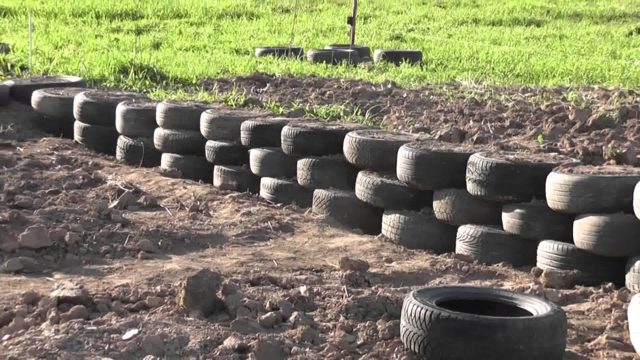 Durability, subject to correct installation of the base
Durability, subject to correct installation of the base
After completing the activities, let the concrete slab sit for a month. After that, you can carry out further work on the construction of the building.
Do-it-yourself deepened tire foundation
The technology for building a recessed-type columnar base is quite simple:
- Develop a drawing for the placement of support columns from tires.
- Make a marking of the coordinates of the supports from car tires.
- Check the accuracy of the markings by comparing the diagonal difference between the corner supports.
- Plan your site and remove rocks, vegetation, roots.
- Prepare pits that are high enough to accommodate at least three ramps.
- Pour a layer of gravel into the troughs and install the slopes, ensuring that the upper planes are at the same level.
- Pour rubble inside the tires, moisten it and tamp it thoroughly.
- Pour with concrete mixture.
 From tires, you can equip both slab and columnar foundations, while the technology of their installation is slightly different
From tires, you can equip both slab and columnar foundations, while the technology of their installation is slightly different
Pros and cons of using car tires
Of course, the biggest advantage of tires is affordability. Buying them at any service station for a penny (or even picking them up for free) is not a problem. Starting the construction of a summer house, gazebo or bathhouse, even at the stage of budgeting, it turns out that the foundation is the most expensive part of the construction. Therefore, saving on material is only welcome.
In addition to availability, the pluses include:
- waterproofing properties of rubber, so the foundation on used tires in places with swampy soil is a very practical and reliable solution;
- durability of tires, because without the destructive influence of ultraviolet radiation, rubber can retain its properties for decades;
- the amortization properties of car tires, which prevent deformation of the house due to ground movements;
- the possibility of constructing the foundation of the building with your own hands, without the use of special machinery and equipment (and even alone).
The tire foundation, obviously, will not replace the traditional one for a massive multi-storey building. However, it is easy and practical to build such a foundation with your own hands under a small country house, garage, shed or bathhouse.
A significant, albeit slightly exaggerated, disadvantage is that rubber, when heated, releases toxic substances. On a hot day, the foundation on car tires may well warm up to a critical temperature.

Shed on a tire foundation
The way out of this situation is to apply an insulating material to the surface of the tires. Regular oil paint is fine. Yes, this is an extra stage of work, but complete safety is guaranteed. In addition, it is not necessary to paint all the tires, only those that are most susceptible to heating (open areas, the upper row of tires) are sufficient.
The appearance of car tires also cannot be called their competitive advantage. Although the same garage will look good, in other cases, cladding materials can be used. This will help to further insulate the rubber and reduce the concentration of emissions into the air.
Necessary equipment for the construction of the foundation
The construction of a tire foundation does not require the use of heavy equipment, except for solving issues of delivery of tires or bulk material. In order to build a base for a garage, a bathhouse, a summer house with your own hands, there are enough tools that can be found in every summer cottage, namely:
- shovel and rake - for removing and leveling the topsoil;
- building level - to check the correct laying of tires;
- timber or wooden board - for leveling concrete;
- concrete mixer or container for the preparation of mortar.
Such a basic set is enough for building a foundation with your own hands in a small area, without any special structural excesses (for a garage, a shed, a gazebo, a stove). If facing work or reinforcement of the foundation will be carried out, an appropriate tool will be required.

Outdoor shower on a tire foundation
In order to save time and money, experienced builders advise not to rent a concrete mixer or prepare the mortar themselves, but to buy concrete by agreeing with a construction organization on delivery. On the agreed day, the mixer will deliver the solution and fill the prepared foundation on car tires.
What materials will be required for the construction of the foundation?
In addition to tires, you need to stock up on such materials for doing work with your own hands:
sand or sand and gravel mixture for compacting and leveling the bottom layer, filling tire cavities, preparing a solution;
soil, broken brick or glass as backfill (here it is important not to use clay soil, which, although it is well compacted, is also easily eroded);
boards for the construction of formwork (if there is no such number of boards, you can rent a removable formwork, many companies provide a similar service);
roofing material, linoleum, dense polyethylene as a waterproofing layer between the rows of tires.
The listed materials are quite enough to make a small foundation of tires with your own hands, for a garage or a change house. If the goal is to build a more solid and reliable foundation for a massive building (for a house made of timber, for example), reinforcing elements, floor slabs will be required.In this case, the cost of the foundation increases and can even be compared with the cost of the traditional tape or pile option.
How I made the base for the house
Consider how I made such a foundation. I will try to describe in steps. First, let's decide on the materials and tools that we need:
- Car tires, the size depends on what kind of structure will be erected. I took from trucks, Gaz-66, Kamaz, Gaz-53, even one from the baker is.
- Geotextile, very little is needed, it fits inside the tire, before filling it with soil
- Any filler, sand, ASG, clay, or a mixture of them, as an option, what is on the site.
- A shovel like this, preferably with such a heavy handle - will be used as a rammer
- Ramming if a shovel with a simple handle
- A car jack, and a few bars as long as the sideways of a tire.
- A pair, or several pairs, of strong hands)))
This is a complete foundation construction kit.
Now the process itself. I'll tell you how I did it, many builders used different methods, but it all boils down to the fact that this method is the simplest, you can find others on the Internet.
- We level the ground if there is a slope. I had a slope of the site, so where the high side of the site is, I removed the fertile layer, about 15-20 cm.On the back side, I poured pillows from a clay-sandy-rocky mixture, which is ready in the quarry, not far from us. Such a mixture turns to stone monumental - it is impossible to break off a piece with a crowbar.
- We put the tires in their places, we try to put them on the same level. I used a laser to mark the horizon. Here is the layout of the columns I have.
Location of foundation tires
- After installing the cover, a piece of geotextile, a bit smaller than the inner diameter of the tire, was laid inside each. This must be done so that the packing does not penetrate into the lower ground under any circumstances.
- We fill the wheels. It should be stuffed without fanaticism, but rather tightly. For convenience, I used a jack. He inserted a jack between the sides, pushed them apart, and inserted a spacer bar. He took off the jack and opened the sides, on the other side. Three spacers were enough for one wheel. We fill it simply - threw it with a shovel to full, then unfold the shovel and ram it with a handle until the tire is filled to the top. I left a small space, it was felt when you stand on the tire, one and a half to two centimeters. After filling the tire, all spacers were removed by pulling. As a result, you should get the effect of an inflated wheel, but not an inflated one. It is more or less visible here.
Tire under load
- As a matter of fact, that's all, on this I finished my foundation. For those who want to raise the house higher, you can put the second and third row of tires, the columns are quite stable, nothing runs away.
What can be a tire foundation
Depending on the expected load and the amount of building materials available, various types of foundations are being erected, by analogy with the classical building practice:
- Tape. In this case, a continuous row of tires filled with crushed stone is located along the entire perimeter of the structure. It is desirable to further strengthen the foundation in depth and width at the corners and support points of the building. This type of foundation, on the one hand, is not very stable and durable. On the other hand, with a competent approach, the load from the entire structure is distributed evenly, and the structure can stand for years without traces of deformation.
- Solid / with concreting. In this case, the tires with crushed stone are distributed evenly over the entire construction area, but are only part of the foundation. The tires are located inside the frame, which limits the area of the future foundation, and the free space is filled with sand or crushed stone, or even cemented.
- Using a slab (most often reinforced concrete). A solid foundation is made according to the same principle as in the paragraph above. Only in this case, not a structure, but a solid slab is placed on the filled with crushed stone and concreted tires. She is already the basis for the building. Such a design is capable of withstanding a fairly large load and is suitable for a bath or a heavier summer cottage.
- In rare cases, rubble tires are used to create a pile support structure. The posts are dug deep into a row of empty tires. The free space is filled with broken brick and rubble in a few approaches, and concreted.
The design of each individual foundation can and should differ depending on what operating conditions and for what structure it is calculated. At the same time, any structure of this type, made of tires, has a number of positive features:
- Significant cost savings: total costs are on average several times lower than analogs;
- High resistance to mechanical damage and weather conditions;
- Wear resistance and reliability, long service life;
- Seismic resistance, although this is irrelevant for most of Russia;
- Easy availability of materials;
- A very simple and fast construction process available to everyone;
With any construction, high efficiency of use is achieved, a minimum of labor and financial costs to obtain a high-quality and reliable result. The most effective with economical are only two types of foundations - with and without crushed stone.

